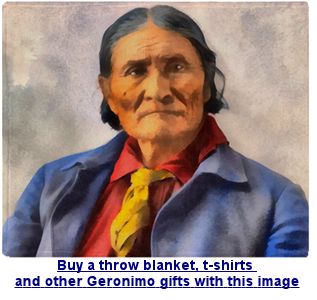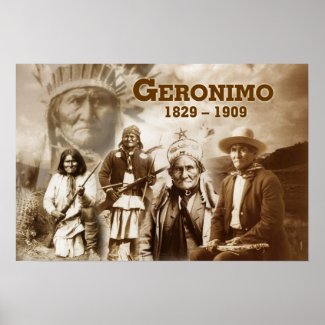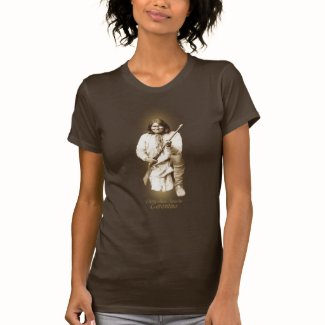Question:
My name is Kaela, I am 26 years old. My father (Eddie Brafford) told me I was Apache. He told me that Geronimo was my great-great uncle. I have never been to a reservation and I am not sure what part of Apache I accend from. I have always been interested in learning about my heritage and I would love to visit a reservation that I belong to. How do I find my tribe and get permission to see my people?
Answer:
 Geronimo was a Bedonkohe Apache, which is a band of the Chiricahua Apache. His parents were Tablishim Goyaale (The Gray One) and Juana. According to Wikipedia, he had three brothers and four sisters. One sister was named Ishton or Ish-key. She married Juh and they had one son named Asa Daklugie. Asa had at least three children. I don’t know their names, but here is a picture of them.
Geronimo was a Bedonkohe Apache, which is a band of the Chiricahua Apache. His parents were Tablishim Goyaale (The Gray One) and Juana. According to Wikipedia, he had three brothers and four sisters. One sister was named Ishton or Ish-key. She married Juh and they had one son named Asa Daklugie. Asa had at least three children. I don’t know their names, but here is a picture of them.
Apache Kinship Terminology
The Apache use the same kindred terminology for cousins and siblings, mothers and mother’s sisters, grandparent and grandchild, father and father’s brothers, aunt or uncle and neices or nephews, etc, so relationships can get very confusing when doing genealogical research. You have to know the context of the sentence in which they are spoken to determine which relationship they mean.
Further, the Apache tribes have two distinctly different kinship term systems: a Chiricahua type and a Jicarilla type which have differences. Also, terms used depend on who is talking, and who they are talking to.
The Chiricahua-type system is used by the Chiricahua, Mescalero, and Western Apache. The Western Apache system differs slightly from the other two systems.
The Jicarilla type is used by the Jicarilla, Navajo, Lipan Apache, and Plains Apache. The Lipan and Plains Apache systems are very similar.
Chiricahua Kinship Terms
The Chiricahua language has four different words for grandparent: -chú “maternal grandmother”, -tsúyé “maternal grandfather”, -chʼiné “paternal grandmother”, -nálé “paternal grandfather”. Additionally, a grandparent’s siblings are identified by the same word; thus, one’s maternal grandmother, one’s maternal grandmother’s sisters, and one’s maternal grandmother’s brothers are all called -chú. Furthermore, the grandparent terms are reciprocal, meaning a grandparent will use the same term to refer to their grandchild in that relationship. For example, a person’s maternal grandmother will be called -chú and that maternal grandmother will also call that person -chú as well (i.e. -chú can mean the child of either your own daughter or your sibling’s daughter.)
Chiricahua cousins are not distinguished from siblings through kinship terms. Thus, the same word will refer to either a sibling or a cousin. There are no separate terms for a parallel-cousin (a cousin from a parent’s same-sex sibling) and a cross-cousin (a parent’s opposite-sex sibling). Additionally, the terms are used according to the sex of the speaker (unlike the English terms brother and sister): -kʼis “same-sex sibling or same-sex cousin”, -´-ląh “opposite-sex sibling or opposite-sex cousin”. This means if one is a male, then one’s brother is called -kʼis and one’s sister is called -´-ląh. If one is a female, then one’s brother is called -´-ląh and one’s sister is called -kʼis.
Two different words are used for each parent according to sex: -mááʼ “mother”, -taa “father”. Likewise, there are two words for a parent’s child according to sex: -yáchʼeʼ “daughter”, -gheʼ “son”.
A parent’s siblings are classified together regardless of sex: -ghúyé “maternal aunt or uncle (mother’s brother or sister)”, -deedééʼ “paternal aunt or uncle (father’s brother or sister)”. These two terms are reciprocal like the grandparent/grandchild terms. Thus, -ghúyé also refers to one’s opposite-sex sibling’s son or daughter (that is, a person will call their maternal aunt -ghúyé and that aunt will call them -ghúyé in return).
Jicarilla Kinship Terms
 Geronimo of the Chiricahua – Buy this Apache Poster Geronimo of the Chiricahua – Buy this Apache Poster |
Unlike the Chiricahua system, the Jicarilla have only two terms for grandparents according to sex: -chóó “grandmother”, -tsóyéé “grandfather”. They do not have separate terms for maternal or paternal grandparents. The terms are also used for a grandparent’s siblings according to sex. Thus, -chóó refers to one’s grandmother or one’s great-aunt (either maternal or paternal); -tsóyéé refers to one’s grandfather or one’s great-uncle. These terms are not reciprocal. There is a single word for grandchild (regardless of sex): -tsóyí̱í̱.
There are two terms for each parent. These terms also refer to that parent’s same-sex sibling: -ʼnííh “mother or maternal aunt (mother’s sister)”, -kaʼéé “father or paternal uncle (father’s brother)”. Additionally, there are two terms for a parent’s opposite-sex sibling depending on sex: -daʼá̱á̱ “maternal uncle (mother’s brother)”, -béjéé “paternal aunt (father’s sister).
Two terms are used for same-sex and opposite-sex siblings. These terms are also used for parallel-cousins: -kʼisé “same-sex sibling or same-sex parallel cousin (i.e. same-sex father’s brother’s child or mother’s sister’s child)”, -´-láh “opposite-sex sibling or opposite parallel cousin (i.e. opposite-sex father’s brother’s child or mother’s sister’s child)”. These two terms can also be used for cross-cousins.
There are also three sibling terms based on the age relative to the speaker: -ndádéé “older sister”, -´-naʼá̱á̱ “older brother”, -shdá̱zha “younger sibling (i.e. younger sister or brother)”. Additionally, there are separate words for cross-cousins: -zeedń “cross-cousin (either same-sex or opposite-sex of speaker)”, -iłnaaʼaash “male cross-cousin” (only used by male speakers).
A parent’s child is classified with their same-sex sibling’s or same-sex cousin’s child: -zhácheʼe “daughter, same-sex sibling’s daughter, same-sex cousin’s daughter”, -gheʼ “son, same-sex sibling’s son, same-sex cousin’s son”. There are different words for an opposite-sex sibling’s child: -daʼá̱á̱ “opposite-sex sibling’s daughter”, -daʼ “opposite-sex sibling’s son.”
As you can see from the above, when perusing old records, relationships can get very confusing, very quickly.
Indian Reservations Associated with Geronimo
Geronimo was associated with several Indian Reservations during his lifetime. From 1850 to 1886 Geronimo joined his Bedonkohe band with members of three other Chiricahua Apache bands: the Chihenne, the Chokonen and the Nednhi.
During those years Geronimo “surrendered” several times to return to live on the San Carlos Apache Reservation in Arizona and the Mescalero Apache Reservation in New Mexico, but something would happen that alarmed him or he felt was unfair, and he would then “break out” again and return to the nomadic life.
During these periods Geronimo would often base himself in the Sierra Madre Occidental Mountains in what is now the country of Mexico.
You can find a series of articles written in Geronimo’s own words that detail the important events in his life in the Famous Apache People section of our website.
In 1886, Geronimo surrendered to General Nelson Miles at Skeleton Canyon after an 11 year pursuit. When he surrendered, his band had been reduced to only 27 people. During the final pursuit of Geronimo’s band, over 5,000 soldiers and 500 indian scouts had been employed in the chase. He surrendered because General Miles told him he would be returned to his homeland after a brief exile in Florida, but he never saw his homeland again.
 |
| Buy this Geronimo shirt |
Instead, Geronimo and others, including the Apache scouts who had helped the army track him down, were sent as prisoners to Fort Sam Houston in San Antonio Texas. The Army held them there for about six weeks before they were transported by rail in cattle cars to Fort Pickens as prisoners of war, in Pensacola, Florida, while his family was sent to Fort Marion, also in Florida. While at Fort Pickens, Geronimo married a new wife named She-gha, but she died the following year.
While at Fort Pickens, he became something of a tourist attraction, and thousands of tourists traveled to the fort to meet him. The constant stream of visitors caused problems for the fort, which was not equipped to deal with them, so in 1888, he was moved to the Mt. Vernon Barracks, near Mobile, Alabama, where he remained until 1894. He was finally reunited with his family in Alabama after an 8 year separation, shortly before they were moved to Oklahoma.
In 1894 he was again moved, this time to the Fort Sill Apache Reservation, in Oklahoma, where he lived the remainder of his life. He died of pneumonia at Ft. Sill in 1909, and is buried in the Fort Sill Apache Indian Prisoner of War Cemetery, along with his daughter Eva, and one of his wives named Zi-Yeh on either side of him. Located a short distance away is another gravestone, engraved “Francisco, wife of Geronimo.”
During his lifetime, Geronimo had 10 or 11 wives, depending on the source you believe, but not all at the same time. Some say two of the wives were possibly the same person who went by different names at different times of her life. The most he had at one time was three wives, but usually he had two, and at the end of his life, he divorced one of his last two wives because the whites said he could only have one wife.
Although Geronimo had at least eight children, and some say as many as 11, more than half of them died young before they had children of their own. It is not known whether he had children or not with some of the wives, or what happened to some of his children. Things are further confused because of the way Apache kinship terminology uses the same words for multiple relationships.
One of Geronimo’s wives was the niece of another famous Apache warrior, Cochise.
His own family was small, but like all Apaches, Geronimo counted all his relatives as his “brothers.” Chief Juh of the Nedhai band in Sonora was a true brother-in-law, as was Chief Nana of the Warm Springs band. When he later married a niece of Cochise, Geronimo acquired not only the greatest Apache leader in history as his uncle, but also Chief Mangas Coloradas of the Mimbreno band as another uncle. His closest “brothers” were Naiche, Victorio, Loco, and Chihauhau, all famous war chiefs in their time.
There are a lot of people who claim to be related to him or who have family stories saying they are related, but can’t prove it. As far as I know, there are only a few verified living direct descendants today. One is a great-grandson named Harlyn Geronimo, who lives in Mescalero, New Mexico. I don’t know him personally.
Ihtedda and Geromino had a child, Lenna, during his fight with the Mexicans and Americans. Ihtedda was a Mescalero. She was held captive during the Prisoner of War days in Florida with Geronimo, but was allowed to divorce Geronimo because he had too many wives for the white men’s rules. She returned to Mescalero with their daughter, Lenna in 1889, where she subsequently married Old Scout, also known as Cross Eyes, soon after arriving on the Mescalero Reservation. Ihtedda then assumed the name, Kate or Katie Crosseyes.
A son was born soon after she arrived back in Mescalero. Since she was already pregnant when she returned to Mescalero, Geronimo is assumed to be his blood father. However, since she married Cross Eyes before the baby was born, he was given the name Robert Cross Eyes. He changed his surname later to Geronimo.
Geronimo’s daughter Lenna married Juan Via, a Lipan Apache, and had three children, Annie Via, Jaunito Via and Percy Via. They would be Geronimo’s grandchildren.
Harlyn Geronimo is the son of Jaunito Via. According to this lineage, he is the Great-Grandson of Geronimo. He later changed his surname from Via to Geronimo.
Harlyn is a Mescalero and Chiricahua Apache who belongs to the Eastern Chiricahua Apaches band known as Shá’i’ánde whose homelands are the Gila wilderness. The book “In Geronimo’s Footsteps: A Journey Beyond Legend” records the journey Harlyn Geronimo and co-author Corine Sombrun took to retrace the steps of Geronimo’s life. The two made a pilgrimage following the Gila River to Geronimo’s birthplace and recounted the stories of Geronimo’s life steeped with family history and Apache lore.
In 1918, President George H. W. Bush’s father, Prescott Bush, along with others, supposedly decimated Geronimo’s tomb and stole his skull and some of his leg bones and took them back to Yale University as a memento for the Skull and Bones Society, one of the many secret Yale societies.
Though the Skull and Bones Society denies these facts, a letter by Winter Mead, member of the secret society (dated June 7, 1918) was discovered in the archives of the Yale University Library, which said in part, “The skull of the worthy Geronimo the Terrible, exhumed from its tomb at Fort Sill by your club & the Knight Haffner, is now safe inside the Tomb together with his well worn femurs, bit & saddle horn…”
Haryln Geronimo has been trying for years to convince the society at Yale to return the remains of his great grandfather for proper burial. He has appeared on many news shows, and in many TV shows about Geronimo and the Apache people.
You can see part of Geronimo’s genealogy tree and other Geronimo family trees on HillGenealogy.com. If anyone reading this has more verified information you can add to this family tree, please email us.
No special permission is required to visit any of the Apache reservations.
To meet relatives that are actually related to Geronimo, you would need to track them down and contact them personally to see if they would like to meet with you.
The only way to truly verify your relationship to Geronimo would be to compile your genealogical family tree, starting with the relatives closest to you and working back to see if you are actually related to Geronimo. When doing genealogy research you always start with the relatives closest to you and work backward, rather than starting with a (potential) famous relative and trying to trace it forward.
Then if you wanted to pursue tribal membership, you would need to track down legal documents such as birth, death and marriage certificates if they exist, or church records of baptisms, or find your Apache ancestors on various tribal Rolls, to verify all this information before you could determine if you really have any Apache people in your family branch.
The Apache tribes may also have a blood quantum requirement (1/4 or 1/8 are common requirements) for enrollment. The exact requirement on blood quantum varies from tribe to tribe. If your Apache ancestor is more than three generations back, or you have Caucasian or another race mixed in your family tree, you may not have enough Apache blood to qualify for tribal enrollment.
Related Links:
Skull and Bones society at Yale University has Geronimo’s skull – Apaches want it back
New lawsuit against Yale Skull and Bones Society regarding Geronimo’s bones
Wives and burial place of Geronimo
Is it possible to find native american genealogy information online without paying for it?
What is a good way for a tourist to experience Native American Culture?